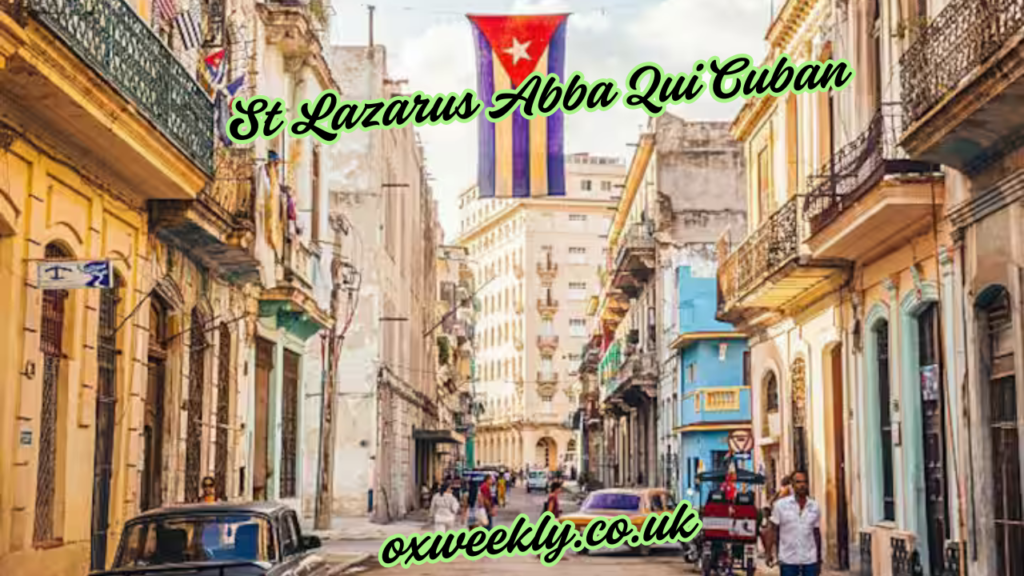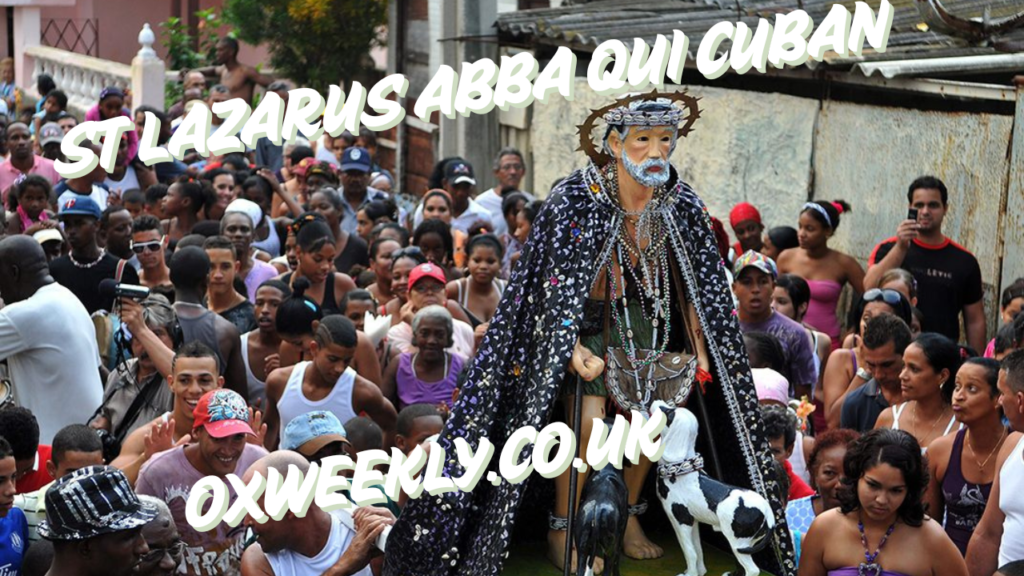Introduction: The Reverence for St Lazarus Abba Qui Cuban
One of the most revered people in Cuban spirituality is St. Lazarus, sometimes referred to as “Abba Qui” in Cuban Catholic traditions. He stands for a deeply ingrained religious and cultural emblem that combines Afro-Cuban and Christian ideas. His picture is often connected to faith, healing, and the human spirit’s tenacity. His devotees across Cuba and abroad dedicate their life to worshiping him in hopes of receiving protection, direction, and miracles.
The devotion to St. Lazarus, especially in Cuba, is a unique fusion of Catholicism and African spiritual traditions, particularly those from the Yoruba religion. His feast day, celebrated annually on December 17th, witnesses thousands of pilgrims traveling to the shrine of “El Rincón” near Havana, demonstrating their unwavering faith.
The Biblical and Catholic Origins of St. Lazarus

In Christian scripture, St. Lazarus is mentioned in two key ways. The first is Lazarus of Bethany, who was raised from the dead by Jesus in the Gospel of John. Christ’s resurrection, which represents rebirth, hope, and the divine mastery over life and death, is one of his greatest miracles. The second is Lazarus, who narrates the narrative of the wealthy man and the beggar in the Gospel of Luke. Lazarus, a poor man with multiple wounds, was rewarded in paradise after being abandoned in this life, demonstrating God’s justice and love.
In Catholic tradition, both figures merge into one, symbolizing suffering, perseverance, and the ultimate reward of faith. St. Lazarus is regarded as a protector of the sick, the poor, and the marginalized, making him a beloved saint among those who endure hardships.
Afro-Cuban Spirituality and the Role of St. Lazarus Abba Qui Cuban
St. Lazarus has a special place in Cuba due to the syncretic nature of the island’s religious heritage. Babalú-Ayé, a Yoruba orisha (deity) who was brought to the island during the transatlantic slave trade, is often confused with him. Associated with illness, epidemics, and recovery, Babalú-Ayé is revered as the goddess of healing.
A distinctive and profoundly significant kind of worship is produced by the mingling of Catholicism with Santería and other Afro-Cuban spiritual traditions. For many Cuban followers, praying to St. Lazarus and performing rites for Babalú-Ayé is inseparable. Cuba’s cultural and religious fusion, where several traditions coexist and enhance one another, is shown by this syncretism.
El Rincón: The Heart of Devotion in Cuba

El Rincón, una pequeña localidad cercana a Havana, alberga el más conocido santuario consagrado a St. Lazarus en Cuba. Todos los años, el 17 de diciembre, thousands de pilgrims se dirigen a esta shrine, algunos crawling, caminando de pie, o llevando grandes objetos como manifestaciones de devoción y sacrificio. Muchos de ellos buscan curar, mientras que otros manifiestan gratitud por los miracles atribuidos a St. Lazarus.
The pilgrimage to El Rincón is an emotional and spiritual experience, marked by prayers, candle lighting, and offerings of flowers, cigars, and purple-colored robes—the saint’s traditional color. It is a powerful example of the deep connection between faith, culture, and the human search for hope and healing.
Symbols and Iconography of St. Lazarus in Cuban Tradition
St. Lazarus is often depicted as an elderly, frail man dressed in tattered robes, leaning on crutches and accompanied by dogs licking his wounds. This imagery comes from the biblical parable, symbolizing humility, suffering, and divine redemption.
In Cuba, numerosas viviendas cuentan con altars consagrados a él, adornados con su statue, candelas y ofrendas. Los fieles creen que St. Lazarus intercede en favor de los enfermos, aportando healing y salvaguarda a sus hogares. His vinculación con purple robes representa devotion, penance, y la resistencia a la adversidad.
Babalú-Ayé, his Afro-Cuban counterpart, is also represented in similar ways, wearing raffia skirts and covered in marks representing disease and recovery. The parallel imagery strengthens the bond between Catholic and African spiritual traditions in Cuban culture.
Rituals, Offerings, and Devotional Practices
Devotees of St. Lazarus engage in various rituals to seek his blessings and protection. Some of the most common practices include:
- Candles de Luz: Candles, particularmente en tonalidades de purple, se encienden como sacrificios y peticiones de salud y miracles.
- Establecer Promesas (Promesas): Numerosos devotos otorgan promesas personales a St. Lazarus en cambio de gracia o favores. These promesas a menudo incluyen gestos de devoción, como caminar largas distancias en pie o realizar acciones de caridad.
- Oferings of Animals: In ceremonies religiosas de Afro-Cuban, sacrifices, especialmente de roosters or goats, are efectuados en honor a Babalú-Ayé, reafirmando así la vinculación del santo con la tradición Yoruba.
- Symbols of Carrying: Small images, medallions, or prints de St. Lazarus a menudo son portadas por los fieles como protective encantos..
These rituals reflect both the traditional Catholic forms of worship and the influence of African spiritual practices, showcasing the unique syncretism present in Cuban religious life.
St. Lazarus and His Impact Beyond Cuba

While St. Lazarus holds a special place in Cuban religious life, his influence extends beyond the island. Many Cuban communities in the United States, particularly in Miami, continue the traditions of honoring him. Churches and homes maintain altars and annual celebrations that mirror those in Cuba, keeping the faith alive among Cuban exiles and immigrants.
In other parts of Latin America, devotion to St. Lazarus is also widespread, particularly in communities with strong Afro-descendant populations. His association with healing and protection resonates deeply with people who seek spiritual support in times of hardship.
The Enduring Legacy of St Lazarus Abba Qui Cuban
St. Lazarus, known as “Abba Qui” in Cuaban devotion, remains one of the most powerful symbols of faith, perseverance, and healing. His figure unites Christian tradition with Afro-Cuban spirituality, demonstrating the resilience and adaptability of religious belief.
The annual pilgrimage to El Rincón, the countless home altars, and the unwavering devotion of his followers show that St. Lazarus continues to play a vital role in Cuban culture and religious life. Whether through Catholic prayers, Santería rituals, or personal acts of faith, his presence is a source of hope and healing for thousands.
Conclusion: A Symbol of Faith and Cultural Identity
La veneración de St. Lazarus Abba Qui Cuban va más allá de simple veneración religiosa; es a profunda tradición cultural que vincula comunidades. His función como protector de los enfermos, los desfavorecidos y los sufrientes lo convierte en un faro de esperanza para muchos. La combinación de influencias Catholicas y Africanas en su culto evidencia Cuba’s abundante espiritual legado, recordándonos que la faith es una fuerza dinámica y cambiante moldeada por la historia, la cultura y la resiliencia humana.
Whether in Cuba, Miami, or other parts of the world, the legacy of St. Lazarus continues to thrive, proving that devotion transcends borders, unites people, and provides comfort in times of need.
Also Read : Yasir Naeem Hunter College: Exploring the Journey, Impact, and Contributions of an Esteemed Scholar

































